An Ahmedabad-based programme which celebrates children who implement socio-economic development programmes in their school neighbourhoods, has ignited the imagination of 1.35 million children and positively impacted 22 million lives in over 30 countries Dilip Thakore & Summiya Yasmeen
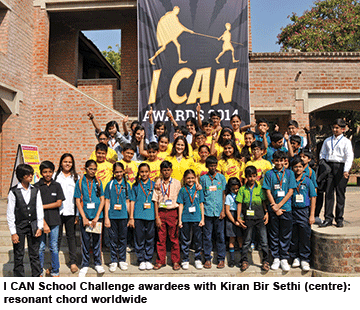 A NEW CHILD EMPOWERMENT and learning-by-doing movement in primary and secondary education centred in Ahmedabad, is capturing the imagination of children, parents and teachers not only in India but around the world. Conceptualised and launched in 2009 by Kiran Bir Sethi, an alumna of the top-ranked National Institute of Design, Ahmedabad and founder-director of the Riverside School (estb.2001), ranked the #2 international day school in the EducationWorld India School Rankings 2014, Design For Change (DFC) is a programme which encourages and celebrates children who implement socio-economic development programmes in the neighbourhood of their schools.
A NEW CHILD EMPOWERMENT and learning-by-doing movement in primary and secondary education centred in Ahmedabad, is capturing the imagination of children, parents and teachers not only in India but around the world. Conceptualised and launched in 2009 by Kiran Bir Sethi, an alumna of the top-ranked National Institute of Design, Ahmedabad and founder-director of the Riverside School (estb.2001), ranked the #2 international day school in the EducationWorld India School Rankings 2014, Design For Change (DFC) is a programme which encourages and celebrates children who implement socio-economic development programmes in the neighbourhood of their schools.
Since 2009, this programme has ignited the imagination and attracted the participation of 1.35 million children in 200,000 schools spanning over 30 countries, to initiate social impact programmes — school infrastructure development, waste management, reafforestation, adult literacy, sanitation and health awareness — which have positively impacted the lives of 22 million people worldwide. Thus far the programme has recorded over 11,000 children-led stories of change which propagate DFC’s I Can inspirational credo.
According to Sethi, she was inspired by her education in the blue-chip NID to ideate a design for the DFC programme — motivated by the can-do activism of Mahatma Gandhi — and to pilot it in Ahmedabad through Riverside students. After transforming this hub of textiles and commerce into “India’s most child-friendly city”, during the past five years she has rolled out the DFC programme nationally and internationally, a rare accomplishment in intellectually insular post-independence India.
Unusually aware that great ideas need to be communicated through hype, hoopla and high-profile celebrations of achievement, Sethi and the Riverside/DFC management team stages an annual Design For Change School Challenge in Ahmedabad — a celebratory event in which the 100 most impactful children-led initiatives from around the country are adjudicated by a high-powered jury, and are awarded cash and other prizes. The latest superbly choreographed and widely publicised DFC School Challenge and I CAN Awards event staged in the spacious premises of the Entrepreneurship Development Institute of India, Ahmedabad on November 22, 2014 was witnessed by your editors.
The day-long event showcased and feted the social impact initiatives of 425 enterprising students and their schools in the presence of a stellar cast of supportive guests of honour including recently-retired test cricket legend Rahul Dravid, nine-times World Billiards champion Geet Sethi (Kiran Bir Sethi’s supportive husband) and well-known actor Rahul Bose. Student-teacher teams of 100 shortlisted schools (from among 2,000 schools from 26 states across the country which submitted entries for the challenge) were presented cash prizes aggregating Rs.7 lakh, in addition to other awards. 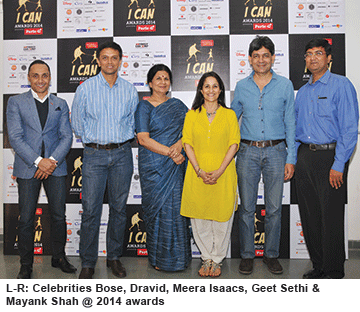
“The Design for Change initiative was founded on the powerful premise: ‘I CAN’. More specifically, children can. By encouraging students to address the challenges that most affect their communities, the DFC programme empowers them to find solutions and lead adults and classmates in this effort. Children are an untapped resource in developing better, more livable communities. Simultaneously the programme creates the potential for leadership and citizenship in the youngest among us, around the world,” says Sethi who developed and fine-tuned this idea after she founded the Riverside School in the new millennium, which has grown into one of the country’s most respected international day schools, highly regarded for nurturing the critical thinking skills of its 390 students (see interview p.60).
Although superficially obvious in concept design and implementation, the DFC programme is revolutionary inasmuch as it accords primary-secondary school children — traditionally passive recipients of information and learning — prime importance, transforming them into proactive leaders of change. This unprecedented acknowledgement that children — whose neural development it is pertinent to note, is 90 percent complete by the time they attain the age of eight — can contribute to socio-economic progress at the grassroots level in their local environments by bringing new perspectives and fresh ideas to age-old problems, and simultaneously enrich their education with learning-by- doing, has struck a resonant chord in student and teacher communities connected with the new power of the internet, around the world. Since it was first incubated in Riverside School whose students tested its “powerful premise” in local communities in Ahmedabad, the DFC programme annually reaches out to 32,000 schools in India with 100,000 children attempting to modify if not eradicate, regressive social traditions and problems such as child marriage, adult illiteracy, environment despoliation, taboos against widow remarriage, caste discrimination, among other pernicious evils.
And unprecedentedly, following an inspirational explanation of the motives and objectives of the programme by Sethi on the TED internet platform (http://bit.ly/1EhRf7l) in 2009 which has received 1.5 million hits and counting, the socio-economic reform and youth involvement message inherent in DFC has resonated with school children and teacher communities around the world. DFC is now an international movement — perhaps the first socio-economic reform idea since the assassination in 1948 of Mahatma Gandhi who exported the ideology of civil disobedience and satyagraha — to find widespread acceptance abroad. Currently children in over 200,000 schools in 32 countries including Argentina, Brazil, China, Denmark, France, Israel, Japan, the UK, and the US are implementing DFC’s FIDS (feel, imagine, do and share) formula to improve their local communities. “Empathy, collaboration, communication and leadership are clearly the most important skills that children learn though Design for Change,” says Sethi.
Student and teacher communities apart, even renowned academics are impressed by the concept and potential of DFC, whose impact is certain to be greater in developing countries where a substantial proportion of in-school students may be first generation learners with the opportunity to introduce adult literacy in their homes. “The DFC I CAN School Challenge programme is a wonderful and constructive gift to schools, communities, the nation and countries around the world,” enthuses Dr. Howard Gardner, professor of education at Harvard University.
“What I love about DFC is that it’s completely student-led, children leading the world and you see this happen in every story,” adds Shaheen Mistri, CEO of Teach for India.
In the pages following, we present case histories of schools which have signed up for the DFC I CAN School Challenge and have enabled their students to learn by doing while arousing and improving their local environments.
|
Any School CAN!
I extend a personal invitation to all principals and teachers reading this EducationWorld cover story. We want every school to sign up with the DFC movement and discover the I CAN superpower of their students! Simply write in to us at india@dfcworld.com. We’ll be thrilled to forward the DFC toolkit and other details to you.
Participation in the DFC I CAN Challenge is free of charge and any school can participate. DFC material is available in ten Indian languages making it genuinely inclusive and user friendly.
After a school applies, the toolkit with the design framework (Feel/Imagine/Do/Share instructions) and teacher tips will be sent to applicant schools by mid-June. Schools need to register their projects online (www.dfcworld.com/dfc/india) by August 15. Once registered, a school can choose any particular week from June to October to execute their DFC I Can Challenge project and submit the story — either as a video or a written submission — online on the DFC website by October 2.
Thereafter, all the Design for Change stories go through a rigorous jury process to select the Top 100 winning entries in India. The jury comprises some of the best design experts and educationists worldwide. All 100 winner schools are honoured at an I CAN Awards Ceremony in November where celebrities, performers, educators and artists celebrate and honour the Superheroes of Change and their mentors.

|
PANCHAYAT UNION MIDDLE SCHOOL, TAMIL NADU
Affordable life-saving jacket
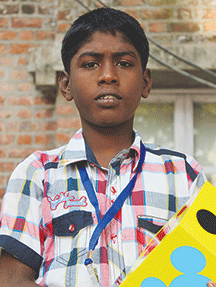 A CLASS VI STUDENT OF THE Panchayat Union Middle School, Muthuramalingapuram in rural Tamil Nadu, N. Rishikesh bagged the ‘Bold Idea’ award and cash prize of Rs.50,000 at the Design for Change I CAN Awards 2014 annual celebratory event staged in Ahmedabad on November 22. His invention: a life-saving jacket made up entirely of discarded plastic water bottles despoiling India’s soil and water bodies.
A CLASS VI STUDENT OF THE Panchayat Union Middle School, Muthuramalingapuram in rural Tamil Nadu, N. Rishikesh bagged the ‘Bold Idea’ award and cash prize of Rs.50,000 at the Design for Change I CAN Awards 2014 annual celebratory event staged in Ahmedabad on November 22. His invention: a life-saving jacket made up entirely of discarded plastic water bottles despoiling India’s soil and water bodies.
The third child of agricultural farm labourers, Rishikesh (11) who spends a lot of his play time on the beaches of Ramanathpuram and neighbouring fishing villages, was disturbed by tragic stories of fishermen losing their lives at sea. “The idea of designing a life-saving jacket came to me when I saw some plastic bottles floating in the sea. I began to research on the physics of flotation and experimented with empty bottles. After much experimentation, I stitched a few dozen plastic bottles to create a life-saving jacket and found it worked really well,” recalls Rishikesh, speaking through a translator.
This almost no-cost life-saving water jacket was submitted to the DFC I Can School Challenge Awards 2014 jury by S. Chitra, a teacher at the Government High School, 17 Astinapuram and projects learning co-ordinator of Tamil Nadu’s Sarva Shiksha Abhiyan (SSA) programme. During the past five years, Chitra has emerged as a DFC movement ambassador in rural Tamil Nadu, which contributed the highest number (1,086) of change stories submitted to the DFC I Can School Challenge awards last year.
Encouraged and enthused by the DFC award, Rishikesh will focus on taking the idea forward and improve his invention to suit the requirements of fisher communities countrywide. “Fishermen cannot afford to buy expensive life jackets. My water jacket costs almost nothing as it is made from waste plastic bottles. An added bonus is that it’s a great way to recycle and reuse discarded plastic. With the help of my teachers and the district collector, I will be reaching out to the fishing community across the country,” vows this young inventor who intends to enlist in the Indian Army.
SAI INTERNATIONAL SCHOOL, BHUBANESWAR
International fairy tale wall
A COLLABORATIVE EFFORT OF 13 students of Odisha’s top-ranked Sai International School (SIS), Bhubaneswar, and 11 students of the Winterbourne International Academy, Bristol (UK), a ‘fairy tale wall’ has brought joy and succour to 700 visually challenged students of the Orissa Association for the Blind School (OABS), Bhubaneswar. 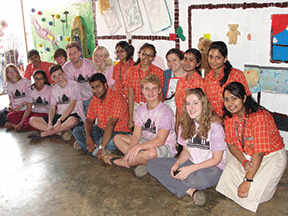
A committed participant of the DFC I Can School Challenge since 2010, the CIE, UK and CBSE-affiliated Sai International — ranked among India’s Top 10 day-cum-boarding schools and #1 in Odisha in the EW India School Rankings 2014 — has a long association with the OAB School. “During our visits, we found the students had access only to Braille story books which are one-dimensional. We wanted them to experience the magic of storytelling through sensory touch and sound and began researching the best way to make this possible. Therefore with students of Winterbourne Academy, we decided to build a sensory wall at OABS,” says Mehak Dhawan, a class XI student of SIS.
Thus a joint development programme was drawn up by students of the two schools over 16 weeks through e-mail and skype exchanges with the inauguration date set for December (2014), when Winterbourne students were due to visit SIS on a week-long exchange programme.
The students decided to depict the timeless Goldilocks with its universal appeal, and project implementation was undertaken by four teams. One team translated the fairy tale into Oriya, another created the characters using 3D material and another prepped the wall, while the fourth voice recorded the story. Finally the team of 24 students from the UK and India worked four full days to build the wall.
“The outcome of this collaborative effort is amazing — a 3D story with sound which stimulates the mind and senses. With a little creativity and the will to make a difference, the participants from two countries have cheered the 700 visually impaired students and teachers of OABS,” says Jessica Patnaik, an SIS teacher who coordinated the project.
MAHABODHI RESIDENTIAL SCHOOL, LEH
Waste management project
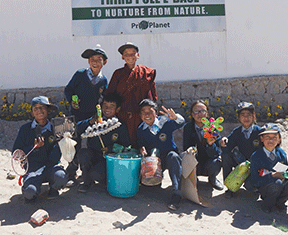 THE CBSE-AFFILIATED mahabodhi residential school (MRS), Leh (Ladakh), was established in 1992 by the Venerable Bhiku Singhasema within the 200-acre campus of the Mahabodhi International Meditation Centre (MIMC), founded by this former Indian Army soldier who took to the Buddhist spiritual path and promoted the centre in 1986. However, the seemingly idyllic campus which attracts people from all over the world, suffers a host of challenges including geriatric loneliness in its old age home, open toilets, lack of sanitation, water, tree cover, wild dogs on the campus and waste management and disposal.
THE CBSE-AFFILIATED mahabodhi residential school (MRS), Leh (Ladakh), was established in 1992 by the Venerable Bhiku Singhasema within the 200-acre campus of the Mahabodhi International Meditation Centre (MIMC), founded by this former Indian Army soldier who took to the Buddhist spiritual path and promoted the centre in 1986. However, the seemingly idyllic campus which attracts people from all over the world, suffers a host of challenges including geriatric loneliness in its old age home, open toilets, lack of sanitation, water, tree cover, wild dogs on the campus and waste management and disposal.
Therefore last September (2014), the MRS management and students took up the Design for Change I Can School Challenge to address the problem of waste management and disposal on the MIMC campus aka Devachan (‘heaven’), as the “project would help MIMC to harmonise with that value”, and if successful, it could be replicated in neighbouring communities and villages.
According to Gautami, a class VIII student of MRS, 175 students volunteered to address the waste difficulty afflicting the campus. They were divided into six groups of cleaners, educators, composters, and dustbin, art and paper managers with six class VII-VIII students appointed leaders of each group. Within two weeks, each group drew up and fulfilled its own sub-project implementation plan. The dustbin group made bins out of discarded cans and plastic bottles. Paper managers found resources on the internet and made recycled paper out of waste, while the compost group learnt the theory of composting and with wood and tools procured from the MIMC office, built a compost maker for converting wet waste into manure.
“We are now dumping all our organic waste into the compost maker, mixing it with water and getting manure instead of burning it,” says Gautami (13) who travelled a long way with class teacher Neha Singh to receive an award for MRS, and whose project was adjudged among the Top 25 countrywide in the DFC I Can School Challenge 2014.
Comments Neha Singh, an arts graduate of Loreto College, Kolkata and former Teach For India fellow who assisted the students to develop the MIMC campus waste disposal project: “The children’s campaign has been adopted by the Ladakh Autonomous Council for managing waste throughout Ladakh district. Moreover, it has had a very beneficial impact upon the students. They have sharply improved their communication skills and understanding of biology, chemistry and environment preservation issues.”
BAL BHARATI PUBLIC SCHOOL, PITAMPURA
Kick-start for gender parity
ALTHOUGHT A WELL-KNOWN PRESCHOOL-CLASS XII institution ranked #18 among Delhi’s co-ed day schools in the EducationWorld India School Rankings 2014, only a tiny minority of girl students of the Bal Bharati School, Pitampura (BBP, estb. 1984) played games or engaged in any sports activity. “The desire to participate in sports, even when instilled in girls, was almost always suppressed by societal pressures and prejudices,” recalls Anushka Dua, a class X student of the school with an aggregate enrolment of 5,339, including 2,357 girl students. 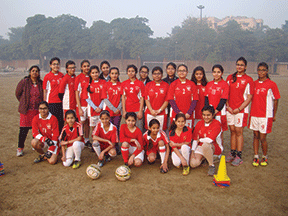
Aggrieved by the neglect of sports education, in April last year, a group of classes IX and X girl students of BBP decided to stand up for their rights. They not only mounted a campaign to encourage girl children of the school to participate in sports and games, but decided to strike a blow for gender egalitarianism by promoting a girls team for a sport dominated by males: football (aka soccer).
“Our preliminary enquiries revealed there were many girls in BBP interested in football, and who wished to play on the field monopolised by boys playing every morning, kicking a ball around among themselves,” says Ria Setiya, a class IX student and a member of the ginger group which promoted the school’s first girls football team last summer with the support of the BBP management.
Determined to strike for gender equality and motivate girl children to derive the benefit of sports education, the 30-year-old school’s first girls football team “shut our ears to acrimonious and sexist remarks” and adopted a rigorous training schedule. Within four months after the BBP’s girls only team was constituted, the school’s management entered it for the prestigious Subroto Cup Inter-school Football Tournament, 2014. The newly-formed team won two matches and made it to the quarter final round of this testing tournament in its initial foray.
Comments Alka Verma who teaches electronics to classes VI-IX students and mentors the girls football team: “Last summer it was difficult for us to make up a girls’ football XI. Now, over 70 girl students are playing the game seriously and we are trying to assemble a girls’ cricket team this year. Health and fitness benefits apart, involvement with the game has done wonders for the motivation and confidence of our girls who have all learned valuable lessons about cooperation and team building.”
ANANDO TRUST, KOLKATA
Avian welfare initiative
 IN AN INCREASINGLY INEGALITARIAN India where the great mass of citizens struggle daily for survival, animal rights receive scant attention. But in a Kolkata slum lacking the most basic amenities, a fraternity of ten boys have built bird houses to safeguard the lives of birds and chicks. Anando Trust (estb. 2006), an NGO which runs two recreation-cum-education centres for slum children in Kolkata, submitted the story of the boys aged 9-12 years — students of a government school — to the DFC I Can School Challenge 2014.
IN AN INCREASINGLY INEGALITARIAN India where the great mass of citizens struggle daily for survival, animal rights receive scant attention. But in a Kolkata slum lacking the most basic amenities, a fraternity of ten boys have built bird houses to safeguard the lives of birds and chicks. Anando Trust (estb. 2006), an NGO which runs two recreation-cum-education centres for slum children in Kolkata, submitted the story of the boys aged 9-12 years — students of a government school — to the DFC I Can School Challenge 2014.
Inspired by classroom lessons highlighting the important role birds play in pest control and cleansing urban environments, the boys resolved to build bird shelters to save and protect their avian neighbours from lashing monsoon rains which routinely injure and even kill some species. “To build the bird houses in trees and household roof corners, we used cardboard pieces and tree leaves which were varnished and painted for water proofing. We also made water receptacles from discarded plastic bottles.
In this way before the 2014 monsoon, we installed six bird houses and feeders in trees and nooks and corners of our basti,” says Tinku Tanli, a class V student of the Lake Model Government Primary School and a regular at the Anando centre over weekends.
Alpana Dewan, a social worker at the Anando Trust, who facilitated the project, says this exercise was an enriching learning experience for the children. “While building the bird shelters and feeders, they learned about the properties of plastic, paint and wood and how to recycle waste material, in addition to learning about cooperation, communication and team work, and about animal rights and environment protection. For all of us, it was a great day when birds began to nest in the bird houses. Now the children are researching new materials to build better nesting boxes and feeders,” says Dewan.
CENTRE POINT SCHOOL, WARDHMAN NAGAR, NAGPUR
Anti foul language initiative
 A CANDLE LIGHT VIGIL organised last september in Nagpur to mourn the tragic death of Yug Chandak, a class II student of the city’s Centre Point School, who was kidnapped and ruthlessly murdered on September 1, made some of his school mates acutely aware that hurling foul language and cuss words is rampant among teenage students. Distressed at the unrestrained use of profanities directed at the deceased’s assailants which marred the solemn ceremony, class IX students of the CBSE-affiliated Centre Point School (CPS) resolved to launch an anti-bad language campaign in the city.
A CANDLE LIGHT VIGIL organised last september in Nagpur to mourn the tragic death of Yug Chandak, a class II student of the city’s Centre Point School, who was kidnapped and ruthlessly murdered on September 1, made some of his school mates acutely aware that hurling foul language and cuss words is rampant among teenage students. Distressed at the unrestrained use of profanities directed at the deceased’s assailants which marred the solemn ceremony, class IX students of the CBSE-affiliated Centre Point School (CPS) resolved to launch an anti-bad language campaign in the city.
The ‘Foul words — Abb Bas’ (‘enough now’) campaign spearheaded by 256 class IX students of the school comprised several initiatives conceptualised and implemented by students. “We were disturbed at how widespread cussing was in school. Children at the receiving end of abuse felt insulted and humiliated. Therefore in September, we designed a series of activities to make youth aware of the harm done by foul, offensive language,” recalls Shiv Batra, a class IX student of CPS, which has 2,844 students on its muster rolls.
“The 256 class IX students were prime drivers of all five activities. From designing DABANGG badges proclaiming ‘I am cool because I don’t use foul language’ to making I Can bracelets forswearing cuss words and enforcing the oath of silence from offenders, they were in the forefront of every activity, using the power of reason and persuasion to stamp out bad language. Every activity was self-motivating and forced introspection. I’m happy to say the campaign has substantially reduced cussing and swearing on the school campus,” says Sana Seth, project facilitator and physics teacher for classes IX and X at the school, who adds that the campaign’s success has motivated Centre Point students to popularise it in other schools of Nagpur.
CHETTINAD VIDYA MANDIR, KARUR
Toilets & sanitation campaign
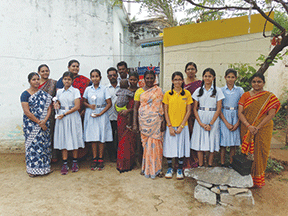 A NEWS REPORT IN THE hindu (may 10, 2014) detailing the acute lack of toilet and sanitation facilities in India and its disastrous public health and environment degradation consequences prompted M.S. Gaaviya Shree, G. Sakthi, K.K. Maahira, A. Prithika Sharone Roseline (class IX) and A. Chelsea Sherine (class X) of the CBSE-affiliated Chettinad Vidya Mandir, Karur (Tamil Nadu) to address this embarrassing problem. A survey of the neighbouring village of Vellalapatti by the students revealed that over 150 homes didn’t have toilets, public toilets were filthy and unusable, and that there was high incidence of diarrhoea-related illnesses among village children.
A NEWS REPORT IN THE hindu (may 10, 2014) detailing the acute lack of toilet and sanitation facilities in India and its disastrous public health and environment degradation consequences prompted M.S. Gaaviya Shree, G. Sakthi, K.K. Maahira, A. Prithika Sharone Roseline (class IX) and A. Chelsea Sherine (class X) of the CBSE-affiliated Chettinad Vidya Mandir, Karur (Tamil Nadu) to address this embarrassing problem. A survey of the neighbouring village of Vellalapatti by the students revealed that over 150 homes didn’t have toilets, public toilets were filthy and unusable, and that there was high incidence of diarrhoea-related illnesses among village children.
To roll out their plan, the quintet enlisted the cooperation of the village panchayat and a local engineer to draw up a budget which estimated the cost of building toilets for 20 homes at Rs.6 lakh. To raise this “huge amount”, the team together with the help of other students organised a range of fund-raising events including a fun fete, and science/maths fair in Chettinad Vidya Mandir (estb.2008), a private school with 1,026 students including 471 girl children on it muster rolls. “We raised Rs.1.36 lakh from these events. To raise the remainder, we approached corporates and the Rotary Club. Impressed with our initiative, Vysya Bank and Rotary International, Karur contributed Rs.4 lakh and a local firm Chettinad Builders, came forward to design the toilets,” recounts Sakthi.
Beyond toilets, the students also set about creating awareness within the public about the critical importance of maintaining clean toilets, sanitation and personal hygiene. Over six months (April-September) last year, the school’s Youth Club students became change-agents, organising salutary public awareness programmes.
“We are absolutely thrilled to hear from villagers about how our students have improved their health, independence and hygiene. Impressed with their work, the district collector has issued application forms to village residents to apply for loans to build toilets under a government scheme. Meanwhile, our students are regularly monitoring the upkeep of the gifted toilets as well as highlighting public awareness programmes. I hope this initiative inspires other schools to do likewise in their local communities,” says principal Vidhya Murali.
GALAXY SCHOOL, RAJKOT
Menstrual hygiene project
EVEN IN 21st CENTURY INDIA — especially small towns and rural areas — because of outdated notions of purity and prudery, women going through their menstrual cycle are often exiled to outhouses and forbidden to cook or pursue their normal routine. Disgusted by this gender discrimination, Aashay Rughani, Hitarth Raja, Shriya Mehta and Shayena Shah — class X students of the CBSE-affiliated Galaxy School, Rajkot (Gujarat) — launched a campaign to address this taboo head on. “During a classroom discussion, we learned about the sorry condition of women in our neighbouring villages who cannot afford to purchase sanitary napkins and neglect associated health risks by making do with waste materials. This awareness bothered us and we resolved to find solutions,” recalls Shriya.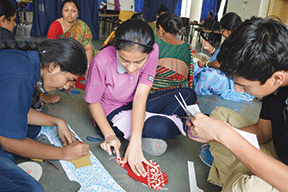
To chart a plan of action, the students interviewed over 70 village women who revealed that high prices of sanitary napkins and the social stigma attached to menstruation forced them to ignore reproductive health issues. Therefore the four-member gender equal students’ team (two boys and two girls) adopted a two-pronged strategy to create awareness about the importance of menstrual hygiene, and design and develop inexpensive sanitary pads. “We held several mixed gender awareness campaigns in neighbouring villages, educating women and men about diseases caused by poor menstrual hygiene and debunked purity myths attached to the period cycle. Moreover, we collaborated with NGOs focusing on women’s health, and came up with a design for a reusable cloth pad. We organised a mega donation rally in school and collected cloth and towels and wrote a five-step manual in Gujarati to instruct women on how to make and sterilise cheap sanitary napkins at home,” says Aashay Rughani.
According to Sakina Bharmal, geography teacher and facilitator of the project, social receptivity to this initiative has been excellent. “With two boys in the four-member team enthusiastically leading this project, Galaxy students as well as rural men and women shed inhibitions about discussing menstrual hygiene. Women appreciated the very cheap, sterilised sanitary napkins which can be made at home. The students have also made a documentary film about the project which will be shared with other schools so they can replicate this initiative,” says Bharmal with evident satisfaction.
VIDYA SAGAR GYANPEETH SCHOOL, SIKKIM
Tathang Melli’s proactive children
 ALTHOUGH RESIDING IN THE scenic village of Tathang Melli in West Sikkim, which hosts a cluster of 20 households, at an altitude of approx. 7,874 ft above mean sea level and offering fantastic vistas of the soaring Himalayas, students of the state board-affiliated Vidya Sagar Gyanpeeth School (VSGS, estb. 2004) which has 109 boys and girls mentored by eight teachers, were bothered by several issues, especially depleting green cover, among other civic problems. However, they were unanimous that the gravest threat was ubiquitous plastic waste and its environmental impact on the scenic rivers, compounded by toxic smoke emanating from burning plastic by local residents.
ALTHOUGH RESIDING IN THE scenic village of Tathang Melli in West Sikkim, which hosts a cluster of 20 households, at an altitude of approx. 7,874 ft above mean sea level and offering fantastic vistas of the soaring Himalayas, students of the state board-affiliated Vidya Sagar Gyanpeeth School (VSGS, estb. 2004) which has 109 boys and girls mentored by eight teachers, were bothered by several issues, especially depleting green cover, among other civic problems. However, they were unanimous that the gravest threat was ubiquitous plastic waste and its environmental impact on the scenic rivers, compounded by toxic smoke emanating from burning plastic by local residents.
Therefore, inspired by the Design for Change I Can School Challenge, last May a group of children from the school drew up a plan to redress the problem of proliferating plastic waste and vanishing green cover. “We imagined clean forests, sparkling rivers and blue skies, and set about making this dream come true,” says Dipendra Rai, a class VIII student.
The project was started with a decision to constitute four teams to address the issues in different ways, utilising the diverse skill-sets and interests of the students. First, they designed posters to display in villages contiguous to their school, to educate people about the hazards of burning plastic and reckless deforestation and its connection with their reducing water resources.
Thereafter, teams of mostly class V-VI students visited Tathang Melli and surrounding villages every week to explain the messages on the posters, going door-to-door to advise people about alternatives to burning plastic waste. Suitably designed dustbins were placed all over the villages with school teams deployed to collect the garbage. Over a period of two months students established a nursery in the school which now supplies plants to village residents to grow in their local environments.
“The DFC I Can School Challenge has enhanced the confidence of primary and upper primary students of VSGS, and taught them the advantages of working cooperatively in teams in ways no textbooks could have. It has also won the school the respect and esteem of people in Tathang Melli and surrounding villages. It has been a very positive experience for the whole school,” says Birkha Bahadur Rai who teaches moral science and social studies to class III-VIII students of VSGS (see charming video on https://www.youtube.com/watch?v=o-zs9Opx-ag).
GUANGZHOU CHILDREN PALACE, CHINA
Sea in the school wallscape
WHILE HUNDREDS OF MILLIONS OF citizens of the neighbouring People’s Republic of China (PRC, pop. 1.4 billion) have been lifted out of poverty and the country is universally acknowledged as a superpower, a downside of the PRC’s socio-economic development miracle is that as a consequence of sudden, unprecedented prosperity, a large number of children especially in urban China have become overweight, and obesity is a major problem. 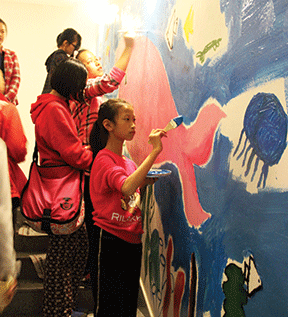
This and the issue of physically challenged children being left behind was addressed by primary school students of the Guangzhou Children Palace School (GCPS) in the southern coastal city of Guangzhou (pop. 14 million) in an innovative fashion, in response to the I Can School Challenge supervised by Design for Change, China, an affiliate organisation of DFC, India.
Agitated by having to witness physically challenged children left behind for long whiles in the daily race for the sole elevator of the five-storied school building, GCPS primary school children hit upon the idea of artistically depicting the flora and fauna of the ocean world on the bare walls of the school staircases, all the way to the top floor, a proposal which was supported after much discussion by the school’s management.
“We realised everyone liked looking at beautiful things. So why not make our walls look beautiful, so people would go sight-seeing up our stairs?” recalls Pingsheng, a class II student explaining the evolution of the Sea in the School project of GCPS.
This unique project was adjudicated one of the country’s Top 25 stories of 2013 by DFC, China as recounted in I CAN Real Super Heroes (2014), a collection of I Can Challenge stories published by DFC, India and Amar Chitra Katha Pvt. Ltd (see also You Tube bit.ly/icandfc-theseainttheschool).
Unsurprisingly, the Sea in the School wallscape painted by children of GCPS has proved a great success. Now, Namren, a challenged wheel-chaired friend of Pingsheng and Ting-Ting, prime movers of the project, seldom has to wait for the elevator.
Comments principal Zhang of GCPS: “I knew this was a good idea. I’m so glad the children came up with it themselves. They take the stairs more often now, and so does everyone who comes to the school.”
“A simple and effective way to educate head and heart”
.gif) What are the major aims and objectives of the Design for Change (DFC) initiative started in 2009?
What are the major aims and objectives of the Design for Change (DFC) initiative started in 2009?
There’s too much focus in education on being the smartest, fastest and strongest. Success is measured more by academic outcomes rather than student well-being. As a result of this ‘either, or’ approach, our children are graduating with content and no character, with a job but with no passion or compassion.
The prime objective of Design for Change is to offer a ‘both, and’ approach to learning — a simple and effective way to educate both the head and the heart. DFC introduces primary-secondary school children to a simple four-step design thinking framework we call FIDS for Kids! We ask children to do four simple things; feel, imagine, do and share.
Using this framework, children around the world are starting to believe they are not helpless, that change is possible and they can drive it! This is their newfound superpower — I CAN!
Looking back over the past five years, how satisfied are you with the growth and impact of the DFC programme?
I am happily dissatisfied. I am happy that in six years since we conceptualised the programme in Riverside School, Ahmedabad in 2009, we have been able to help children in over 200,000 schools worldwide acquire the I CAN superpower. But I am still dissatisfied that we are yet to reach out to every child.
It’s also hugely satisfying that DFC is perhaps the world’s most inclusive initiative. Our material is available in over 14 languages — 10 Indian and four international — and growing, with 44 percent of participation coming from urban schools, 37 percent from rural, and 19 percent from semi-urban schools.
What are some notable outcomes of the DFC programme?
Some of the most inspiring stories have come from rural India. Children have used our FIDS — feel, imagine, do and share — mindset in their local communities with amazing results. For example in 2009, a group of ten-year-olds in Baliyawali Talai in Rajasthan motivated people in their village to implement effective rainwater harvesting solutions. In another inspiring story from Lordi Dejgara village in Jodhpur, Rajasthan, children successfully challenged the practice of child marriage, managing to prevent the marriage of 16 underage girls.
Driven by such stories and examples, children worldwide are learning that they have as much power to change their lives and communities as the adults who educate and shape their lives. This sentiment of agency and advocacy will remain with these children through their entire lives, encouraging them to remain engaged and active in their communities.
To a great extent, implementation of the DFC programme in schools across the country requires the cooperation of the teachers’ community. How satisfied are you with their support to the initiative?
Support of the teachers’ community is crucial for implementation of the DFC programme. Therefore I am deeply grateful for their support which has grown significantly during the past six years. Research conducted by us indicates teachers’ appreciation of DFC for its positive impact on students, especially because it enables them to help their local communities. Through participation in the DFC challenge, teachers are ‘reminded’ of the values they cherish and such renewed awareness reinforces their socio-educational commitment.
What is the annual budget of DFC and what is the ‘business model’ of the initiative?
One of the reasons Design for Change has ‘stickiness’ is that we have some of the best minds attached to it. Our strength is in the weight of all the minds and voices attached to the organisation. From Dr. Howard Gardner and the team at GoodProject, to the faculty and alumni of National Institute of Design, from our knowledge partners at the d.school in Stanford to the designers at IDEO. That itself is our best promotion.
We are a not-for-profit and as the DFC programme is free, we have always worked on a very lean budget, making it a challenge to raise funding. The operational programme budget this year is in the range of Rs.65-70 lakh.
Looking ahead, what are your future plans to rollout the DFC programme nationally and internationally?
Currently we work with over 25 NGO partners in India focusing on capacity building and teacher training. We will also actively look at opportunities to establish more institutional partners and work with state governments to expand our footprint in India.
Going forward, we are focusing on advocating the design mindset in education. This year our 50-hour design thinking curriculum is being piloted in 60-plus schools across the country. We are also exploring avenues to work at the policy implementation level with the Central and state governments to make a wider impact.